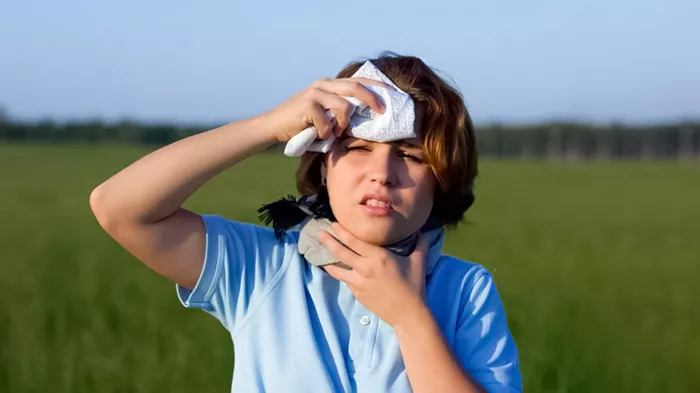Sunstroke, also known as heatstroke, is a severe form of heat illness resulting from prolonged exposure to high temperatures and dehydration. It can be life-threatening and requires immediate medical attention. The duration of sunstroke symptoms and recovery time can vary based on several factors, including the severity of the condition, the timeliness of treatment, and the individual’s overall health.
The duration of sunstroke can range from a few hours to several days, depending on the severity and promptness of treatment. In mild cases, symptoms may resolve within a few hours of proper hydration and cooling. However, more severe cases can take several days or even weeks for full recovery. The key is early recognition and treatment to minimize the duration and severity of symptoms.
Recognizing Sunstroke Symptoms
Sunstroke symptoms typically develop after prolonged exposure to high temperatures or strenuous physical activity in hot weather. Key symptoms include:
High body temperature (above 104°F or 40°C)
Hot, dry skin or profuse sweating
Confusion, agitation, or disorientation
Rapid pulse
Headache
Dizziness or lightheadedness
Nausea and vomiting
Muscle weakness or cramps
Seizures
Unconsciousness
These symptoms can escalate quickly, making it crucial to seek immediate medical attention if sunstroke is suspected.
Immediate Response to Sunstroke
The first step in managing sunstroke is to lower the person’s body temperature. This can be done by:
Moving the person to a cooler environment: Ideally, indoors with air conditioning or at least a shaded area.
Applying cool water: Use a sponge, hose, or shower to cool the person. Ice packs can be placed on the neck, armpits, and groin.
Rehydration: Give the person water or sports drinks if they are conscious and able to drink. Avoid caffeine and alcohol as they can exacerbate dehydration.
Monitor vital signs: Keep an eye on the person’s temperature, pulse, and breathing until medical help arrives.
See Also: Topics to Talk About: What to Eat During Heat Exhaustion?
Treatment and Recovery
Once medical help is obtained, treatment may include intravenous fluids, medications to prevent seizures, and other interventions to stabilize the patient’s condition. The recovery period varies based on the severity of the sunstroke:
Mild Cases: With prompt treatment, mild cases of sunstroke may resolve within a few hours to a day. The individual should rest and stay hydrated.
Moderate to Severe Cases: These may require several days to weeks of recovery. Hospitalization may be necessary to monitor and treat complications such as kidney damage,respiratory issues, or heart problems.
Factors Affecting Recovery Duration
Several factors influence how long sunstroke lasts and the recovery time:
Severity of Sunstroke: Severe sunstroke with complications will require a longer recovery period.
Timeliness of Treatment: Quick and effective treatment can shorten the duration of symptoms and prevent complications.
Individual Health: Pre-existing health conditions such as heart disease, diabetes, or respiratory issues can prolong recovery.
Age: Older adults and young children are more vulnerable to heat illnesses and may take longer to recover.
Hydration Levels: Proper hydration before, during, and after exposure to heat can influence recovery time.
Long-Term Effects and Complications
In some cases, sunstroke can have long-term effects, particularly if not treated promptly. Potential complications include:
Organ Damage: Prolonged high body temperature can damage vital organs such as the heart, kidneys, liver, and brain.
Neurological Issues: Severe sunstroke can cause lasting neurological damage, leading to memory problems, concentration issues, and other cognitive impairments.
Heat Intolerance: Some individuals may develop a heightened sensitivity to heat and a reduced ability to regulate body temperature, increasing the risk of future heat-related illnesses.
Heat Cramps: Painful muscle contractions caused by the loss of salts and fluids from sweating.
Preventing Sunstroke
Preventing sunstroke is essential, especially during hot weather or when engaging in outdoor activities. Key prevention strategies include:
Stay Hydrated: Drink plenty of fluids, especially water, throughout the day. Avoid alcohol and caffeine.
Wear Appropriate Clothing: Light-colored, loose-fitting clothing helps keep the body cool.
Limit Sun Exposure: Avoid direct sun exposure during peak hours (10 a.m. to 4 p.m.). Seek shade or use umbrellas and hats.
Use Sunscreen: Apply broad-spectrum sunscreen with an SPF of at least 30 to protect your skin from harmful UV rays.
Take Breaks: When engaging in physical activity, take frequent breaks in a cool or shaded area to prevent overheating.
Monitoring and Early Intervention
Early intervention can prevent sunstroke from escalating. Monitor yourself and others for early signs of heat-related illnesses, such as:
Heat Cramps: Muscle pains or spasms due to heavy sweating.
Heat Exhaustion: Symptoms include heavy sweating, weakness, dizziness, nausea, and headache.
Address these symptoms promptly to prevent progression to sunstroke.
Conclusion
The duration of sunstroke varies based on the severity of the condition and the promptness of treatment. Mild cases may resolve within hours, while severe cases can take days or weeks for full recovery. Recognizing symptoms early, providing immediate care, and seeking medical attention are crucial for minimizing the duration and severity of sunstroke. Prevention strategies, such as staying hydrated, wearing appropriate clothing, and avoiding excessive sun exposure, are essential to reduce the risk of sunstroke.
FAQs
What should I do if I suspect someone has sunstroke?
Move them to a cooler place, apply cool water, and give them fluids if they are conscious. Seek immediate medical attention.
Can sunstroke cause long-term health problems?
Yes, severe sunstroke can lead to organ damage, neurological issues, and increased heat sensitivity.
How can I prevent sunstroke during outdoor activities?
Stay hydrated, wear light clothing, limit sun exposure, use sunscreen, and take frequent breaks in cool areas.
Related topics:
- How to Fix Heat Stroke: Immediately Effective Method
- Dealing with Severe Sun Poisoning: A Comprehensive Guide
- Understanding Heat Intolerance: Causes, Effects, and Management Strategies


